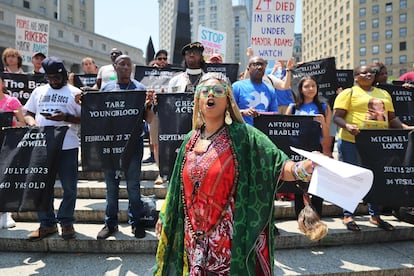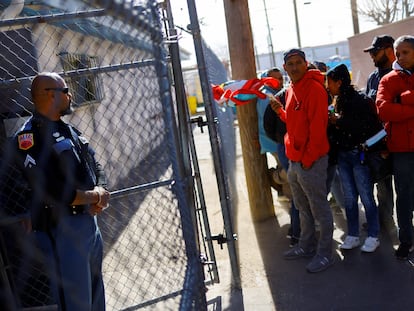US attorney calls for federal takeover of New York’s jails as Rikers Island crisis worsens
A total of 25 inmates have died in or shortly after leaving the prison, which is slated for closure in 2027, since Mayor Eric Adams took office in January 2022


The New York judiciary has called for intervention in the city’s prison system in the face of the rampant crisis at the Rikers Island jail complex, where a succession of inmate deaths and abuse of power by officials are combining explosively. Damian Williams, U.S. attorney for the Southern District of New York, recently requested federal government intervention in New York’s prisons, wresting decision-making power from the city council of Democratic Mayor Eric Adams. The decision whether to appoint a receiver will be made in the U.S. District Court on August 10.
Williams’ recommendation is a setback for Adams, who won the mayoral election on a clear law-and-order message but finds himself entangled in security issues. Keechant Sewell, the chief commissioner of the New York Police Department (NYPD) — the largest in the country and in which Adams previously served — surprisingly resigned a few weeks ago after a little more than a year and a half in the post, allegedly over a lack of autonomy.
Eight years after a historic agreement with New York City to reform Rikers Island, attempts to straighten out a facility that many describe as a house of horrors have proved futile. If U.S. Attorney Williams’ proposal to cede control to Washington is approved by a federal judge, the administrator would not only remove decision-making power from the city administration, but possibly do away with union agreements and other long-standing labor standards.
“This is a collective failure with deep roots, spanning multiple mayoral administrations and DOC commissioners,” Williams said on July 17. “After eight years of trying every tool in the toolkit, we cannot wait any longer for substantial progress to materialize.” His announcement came two days after the death of William Johnstone, the 25th inmate to die in custody or shortly after release since Adams took office in January 2022. The tragic list includes suicides, overdose cases and a high incidence of mental health problems among the prison population, which are not properly treated. A week after Johnstone’s death, an officer was suspended following the death of another inmate, the second fatality in 15 days and the seventh so far this year.
Adams, who frequently pointed to his professional experience as a police officer to garner votes during the mayoral election campaign, finds himself on the ropes. He opposes any concessions such as the one recommended by Williams and enthusiastically backs the current commissioner of prisons. But in practice he is alone, with no support other than that of the prison officers’ unions. The municipal comptroller, the ombudsman, several councilors and human rights organizations have long been demanding a judicial administrator to address the crisis. Protests about conditions in the prison are frequent.
However, Rikers is not the only prison in New York facing problems. The Brooklyn correctional facility, famous for housing high-profile inmates such as Ghislaine Maxwell and many drug traffickers, is bursting at the seams due to overcrowding. The Manhattan jail where Jeffrey Epstein committed suicide in August 2019, known as New York’s Guantanamo Bay, was closed for failing to meet minimum conditions of habitability and security.
The federal courts have been directly involved in Rikers since 2015, when one of Williams’ predecessors reached a deal with the city to tackle violations of the constitutional rights of detainees in the city’s jails. The agreement was the result of a landmark lawsuit filed by the Legal Aid Society, in which it was alleged that jail officials were abusing detainees so severely and systematically that drastic action was required. A federal observer, Steve Martin, was appointed to oversee the reforms and his office has issued dozens of reports describing worsening security and living conditions. “The current state of affairs and rates of use of force, stabbings and slashings, fights, assaults on staff, and in-custody deaths remain extraordinarily high — they are not typical, they are not expected, they are not normal,” reads a recent report. Minimum hygiene conditions are conspicuous by their absence.

Plans to close Rikers by 2027
The New York prison system is increasingly deadly and dangerous, exacerbated by the confinement imposed by the coronavirus pandemic and absenteeism, coupled with periodic sit-down strikes by officials protesting a lack of means. In 2017, under Mayor Bill de Blasio, a decade-long Rikers closure plan was agreed upon — a move also backed by Adams, who has described the prison as a “national disgrace” — but the timeline is facing setbacks and federal intervention is more a desperate attempt to plug the holes than a programmatic solution. The numbers have put the brakes on any expectations: New York’s largest prison houses more than 6,000 inmates — mostly pretrial detainees but also a small percentage of those convicted of misdemeanors — and averages 100,000 admissions annually.
Martin’s impatience has gone so far as to ask that the city be held in contempt for failing to ensure the normal operation of the jail. In his request, the federal observer underlined the fact that officials have totally lost control of the facility. The agreement providing for the closure of Rikers in 2027 remains in place with new, smaller jails being built in four districts of the city, but the new facilities will only be able to hold 3,300 inmates, half of Rikers’ current population.
In addition to the image setback for Adams, the debate on prisons contains a key question: the viability of the current management model, in which private jails — New York’s are municipally managed — monopolize practically all the revenues. The USA has the largest number of prisoners in the world and the highest proportion of the population behind bars: 2.2 million at the end of the last decade. According to NGO The Sentencing Project, which advocates reform of the system, of the national ratio of 350 prisoners per 100,000 inhabitants (in some states, such as Louisiana, Oklahoma or Mississippi, this ratio is doubled), only 43 are in federal prisons; the rest, 307, are serving their sentences in private facilities. At the end of the last decade, the private prison business in the U.S. was worth $3 billion per year.
Sign up for our weekly newsletter to get more English-language news coverage from EL PAÍS USA Edition
Tu suscripción se está usando en otro dispositivo
¿Quieres añadir otro usuario a tu suscripción?
Si continúas leyendo en este dispositivo, no se podrá leer en el otro.
FlechaTu suscripción se está usando en otro dispositivo y solo puedes acceder a EL PAÍS desde un dispositivo a la vez.
Si quieres compartir tu cuenta, cambia tu suscripción a la modalidad Premium, así podrás añadir otro usuario. Cada uno accederá con su propia cuenta de email, lo que os permitirá personalizar vuestra experiencia en EL PAÍS.
¿Tienes una suscripción de empresa? Accede aquí para contratar más cuentas.
En el caso de no saber quién está usando tu cuenta, te recomendamos cambiar tu contraseña aquí.
Si decides continuar compartiendo tu cuenta, este mensaje se mostrará en tu dispositivo y en el de la otra persona que está usando tu cuenta de forma indefinida, afectando a tu experiencia de lectura. Puedes consultar aquí los términos y condiciones de la suscripción digital.
More information
Archived In
Últimas noticias
‘Doctor Death’, the journalist who has witnessed 105 executions in Florida
Being trans or gay in a migrant detention center: ‘They call me faggot, queer, bitch’
The metaverse, four years later: Is it finished or just at a standstill?
$3,000 and a plane ticket: The United States increases incentives for migrants to self-deport before the end of the year
Most viewed
- The low-cost creative revolution: How technology is making art accessible to everyone
- Christian Louboutin: ‘Young people don’t want to be like their parents. And if their parents wear sneakers, they’re going to look for something else’
- All the effects of gentrification in one corner of Mexico’s Colonia Roma
- Liset Menéndez de la Prida, neuroscientist: ‘It’s not normal to constantly seek pleasure; it’s important to be bored, to be calm’
- Christmas loses its festive spirit: ICE fears cast shadow over religious celebrations










































